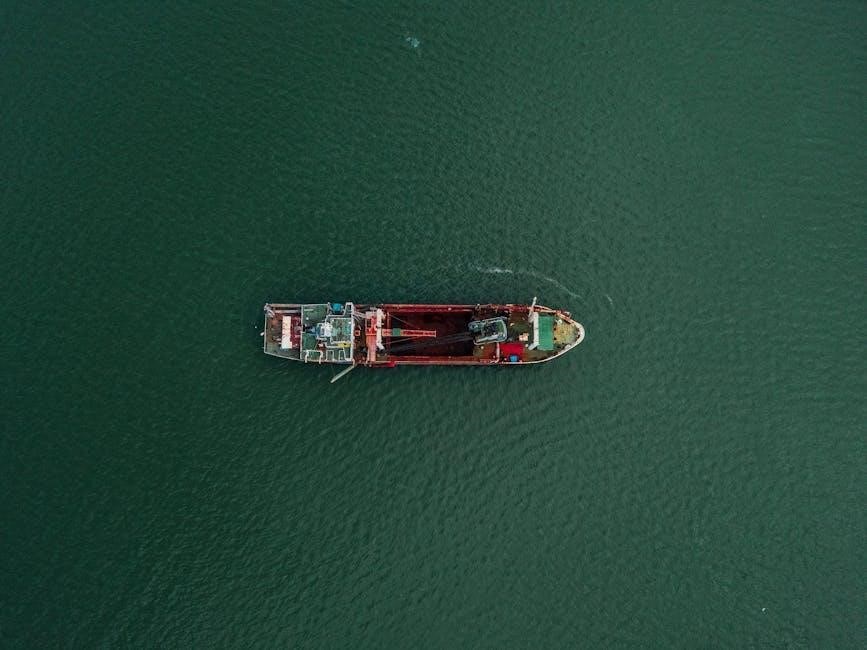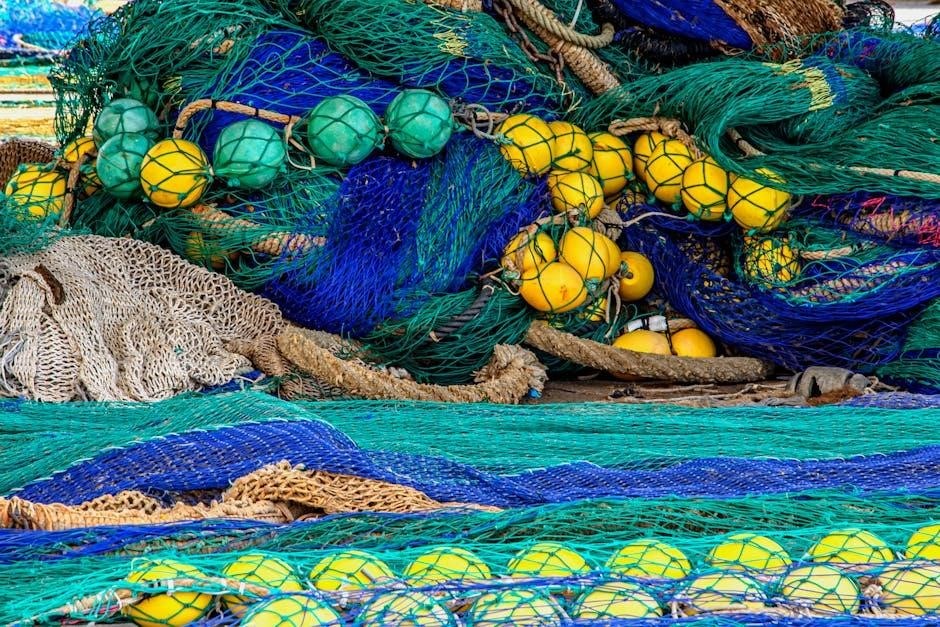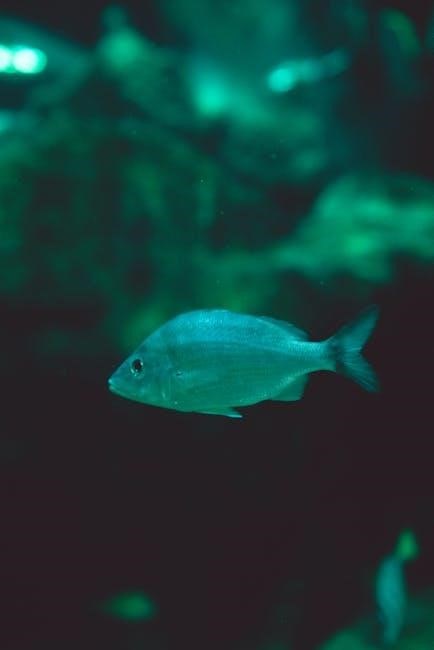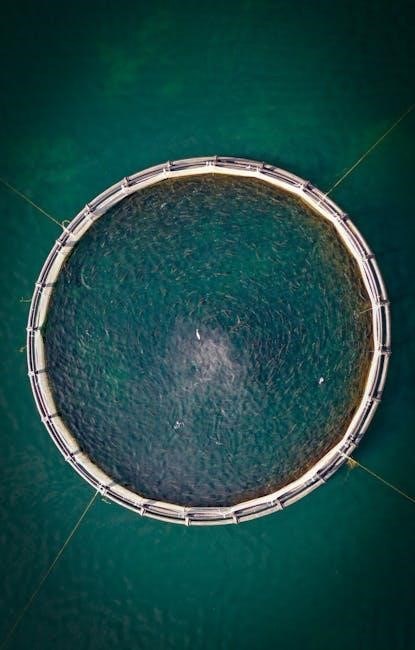
Fisheries are a vital source of food and livelihood for millions globally, encompassing marine and freshwater ecosystems. They play a crucial role in food security, economies, and cultural practices worldwide.
Overview of Fisheries and Their Importance
Fisheries are a critical component of global food systems, providing a primary source of protein for millions of people. They encompass both marine and freshwater ecosystems, supporting diverse species that are harvested for human consumption and industrial purposes. Fisheries play a vital role in food security, particularly in coastal and rural communities, where they often serve as a primary livelihood. Beyond their nutritional value, fisheries contribute significantly to local and national economies, generating income and employment opportunities. Additionally, they hold cultural and social significance, often being integral to traditional practices and community identities. However, the importance of fisheries extends beyond human benefits, as they are essential for maintaining biodiversity and ecological balance in aquatic environments. Sustainable management of fisheries is crucial to ensure their long-term productivity and the preservation of marine and freshwater ecosystems for future generations.

Types of Fisheries
Fisheries are broadly categorized into marine and freshwater fisheries. Marine fisheries focus on ocean resources, while freshwater fisheries operate in rivers, lakes, and wetlands, supporting diverse aquatic species.
Marine Fisheries
Marine fisheries are a significant contributor to global fish production, accounting for approximately 88% of total fish catches. These fisheries operate in ocean waters and target species such as sardines, mackerel, tuna, and grouper. According to the United Nations Food and Agriculture Organization, marine fisheries provide about 50% of the world’s total fish supply. The fishing operations vary in scale, ranging from small-scale artisanal fisheries to large industrial fleets. Marine ecosystems are rich in biodiversity, with around 240 species contributing to marine fisheries. However, these fisheries face challenges such as overfishing, habitat degradation, and the impacts of climate change. Sustainable management practices are essential to ensure the long-term health of marine ecosystems and the communities that depend on them. Effective monitoring and multi-annual management plans are critical to achieving these goals and maintaining the productivity of marine fisheries.
Freshwater Fisheries

Freshwater fisheries operate in rivers, lakes, reservoirs, and wetlands, contributing significantly to global fish production. These fisheries support diverse fish species such as carp, catfish, and trout, and are vital for food security and livelihoods in many regions. Freshwater ecosystems are often more vulnerable to environmental changes, including pollution, overfishing, and habitat degradation. Sustainable practices, such as regulated fishing and aquaculture, are essential to maintain healthy fish populations. Freshwater fisheries also play a key role in local economies, particularly in developing countries where they provide a primary source of protein and income. According to the Handbook on Fisheries Statistics, freshwater fisheries are managed through pre-impoundment surveys and stocking strategies to optimize production. Balancing ecological conservation with economic benefits remains a critical challenge for freshwater fisheries worldwide. Effective management ensures the long-term sustainability of these vital aquatic resources.

Fisheries Management
Fisheries management involves regulating fishing activities to ensure sustainable use of aquatic resources. It includes monitoring fish populations, enforcing catch limits, and implementing conservation measures to maintain ecosystem balance and long-term productivity.
Sustainable Fisheries Management Practices
Sustainable fisheries management practices aim to balance the ecological, economic, and social benefits of fishing. Key strategies include monitoring fish populations, setting catch limits, and enforcing recovery plans for overfished species. Implementing multi-annual management plans ensures long-term sustainability. Reducing bycatch and discarding through improved fishing gear and techniques is critical. Marine protected areas and seasonal closures help replenish fish stocks and preserve habitats. Certification programs, such as those for sustainable seafood, promote responsible fishing practices. Engaging local communities in co-management fosters stewardship and compliance. Additionally, integrating ecosystem-based approaches addresses broader environmental impacts. These practices ensure that fisheries remain viable for future generations while maintaining healthy marine ecosystems.
Economic Importance of Fisheries

Fisheries play a crucial role in the global economy, providing livelihoods for millions of people worldwide. The industry generates significant revenue through seafood production, processing, and trade. Approximately 38% of all seafood is exported, making fisheries a vital component of international trade. In developing countries, fisheries often serve as a primary source of income and food security for coastal communities. The sector supports over 200 million jobs globally, both directly and indirectly, through fishing, aquaculture, and related industries. Additionally, fisheries contribute to national economies by generating billions of dollars annually. They also foster economic diversification through value-added products and tourism. However, challenges such as overfishing and illegal activities can undermine long-term economic stability. Sustainable management practices are essential to ensure the continued economic benefits of fisheries for future generations.
Environmental Impact of Fisheries

Fisheries significantly affect marine and freshwater ecosystems, often leading to environmental degradation. Overfishing depletes fish populations, disrupting food chains and biodiversity. Fishing gears like trawls and dredges damage habitats, such as coral reefs and seagrass beds, which are critical for marine life. Bycatch, the catching of non-target species, including endangered fish, seabirds, and marine mammals, further exacerbates ecological harm. Additionally, discarding unwanted catch contributes to ocean pollution and waste. Aquaculture, while providing an alternative to wild fishing, can introduce invasive species and generate excess nutrients, leading to eutrophication. Climate change also impacts fisheries, altering fish distributions and productivity. To mitigate these impacts, sustainable practices like catch limits, marine protected areas, and eco-certification of seafood are essential. Addressing these challenges requires a balance between human needs and environmental preservation to ensure healthy ecosystems for future generations.

Fisheries Policy and Governance
Fisheries policy and governance are crucial for ensuring the sustainable use of aquatic resources. The Common Fisheries Policy (CFP) in the EU aims to manage fish stocks sustainably and promote a competitive fishing industry. Post-Brexit, the UK now has authority over its fisheries policy, allowing for tailored management strategies. Effective governance involves setting catch limits, monitoring compliance, and enforcing regulations to prevent overfishing and illegal activities. International agreements and organizations play a key role in coordinating efforts across borders. Transparent decision-making and stakeholder involvement are essential for balanced policies that address environmental, social, and economic needs. Strong governance frameworks help mitigate conflicts and ensure equitable access to resources, fostering long-term sustainability in fisheries worldwide.

Technological Advancements in Fisheries
Technological advancements have revolutionized the fisheries sector, enhancing efficiency, sustainability, and monitoring. Acoustic devices now transform echoes into detailed fish stock assessments, enabling precise management; Electronic monitoring systems and satellite tracking improve enforcement, reducing illegal fishing. AI and big data analyze ocean conditions, optimizing fishing operations and reducing bycatch. Innovations in aquaculture, such as recirculating water systems, boost production while minimizing environmental impact. These technologies not only address sustainability but also ensure the industry adapts to global challenges, fostering a balance between resource use and conservation.

Challenges and Future Directions in Fisheries
Fisheries face significant challenges, including overfishing, habitat degradation, and climate change, which threaten biodiversity and food security. Future directions emphasize sustainable practices, such as catch limits and marine protected areas, to restore fish stocks. International cooperation is crucial to address illegal fishing and ensure equitable resource use. Technological innovations, like acoustic monitoring and eco-labeling, can enhance transparency and accountability. Aquaculture expansion offers a promising solution to meet rising demand while reducing pressure on wild fisheries. Strengthening governance frameworks and investing in research will be vital to balance ecological and economic needs, ensuring fisheries contribute sustainably to global food systems and livelihoods for future generations.